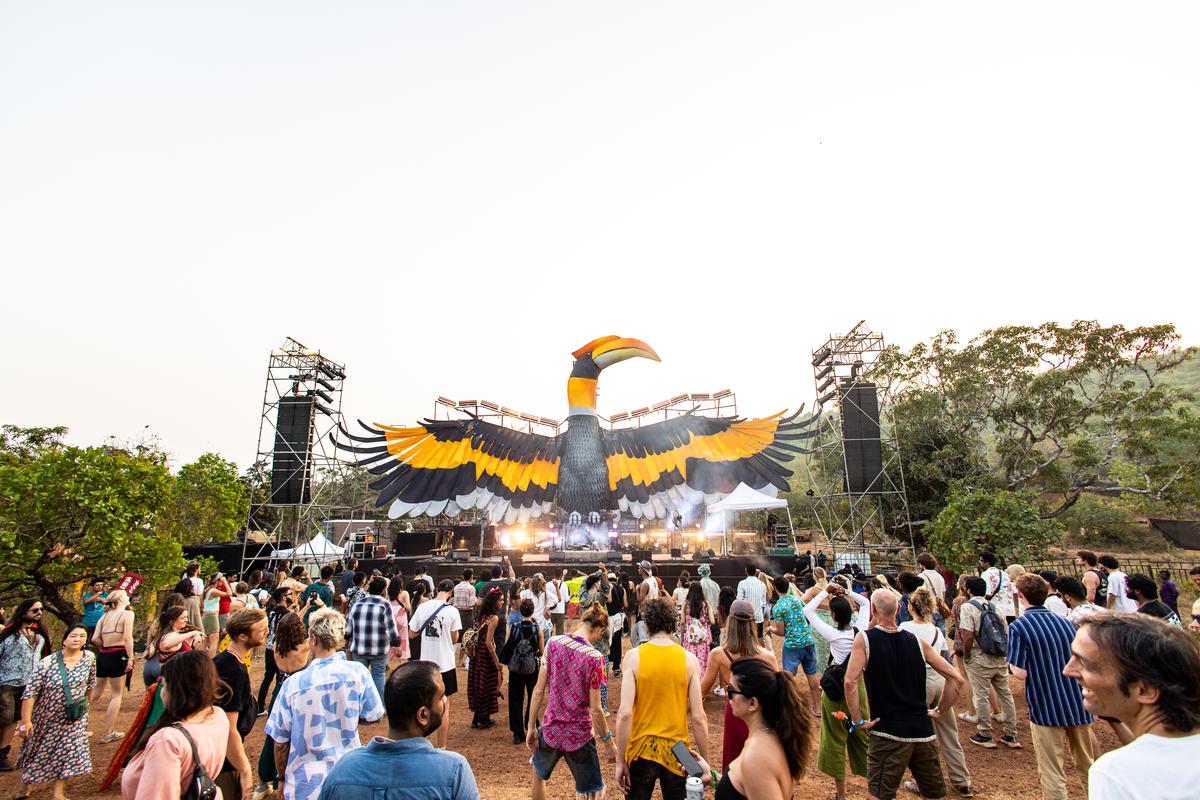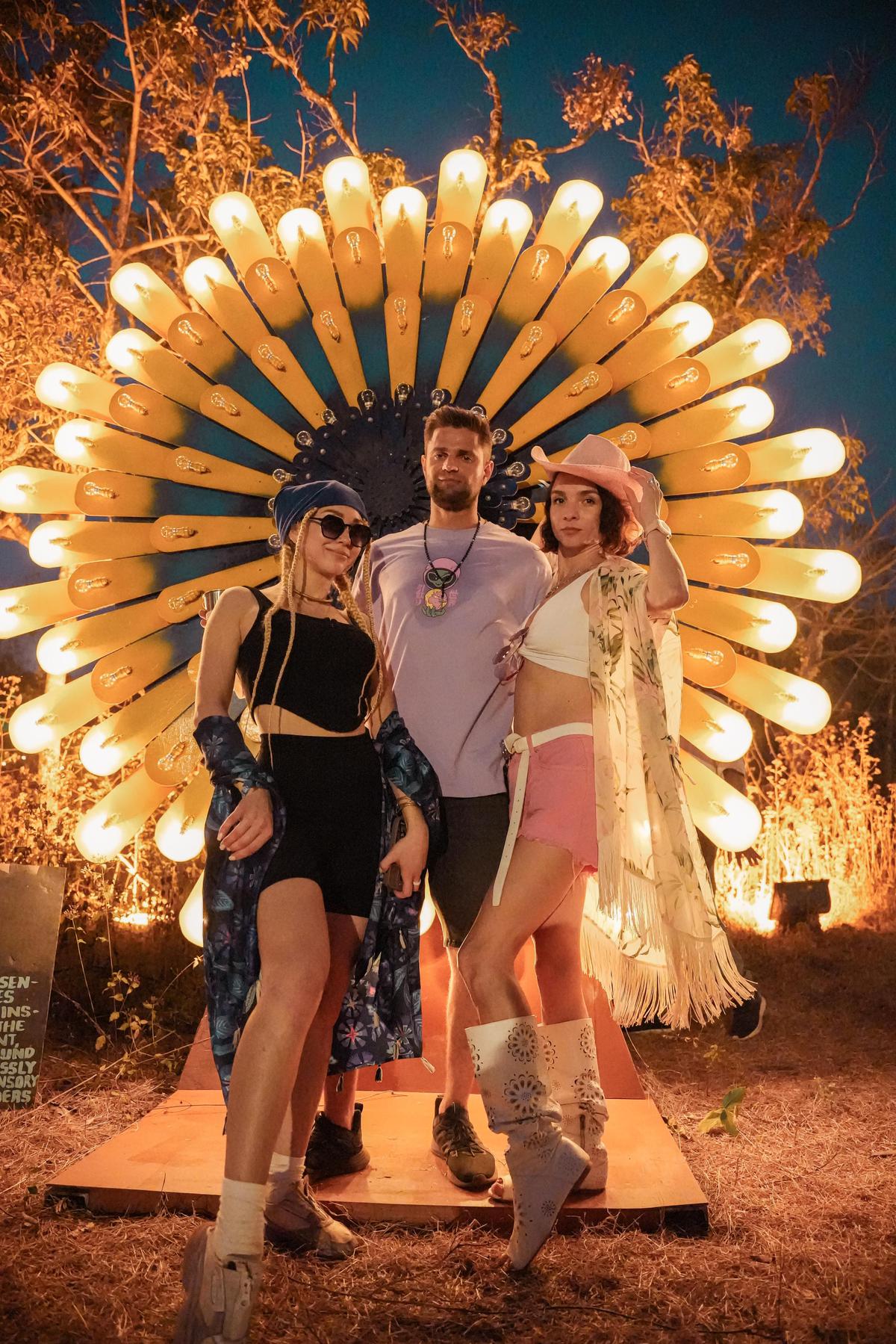Nestled amidst a lush forest at Chopdem Morjim in Goa, a line-up of over 40 international artistes perform live music on four uniquely-designed stages at sunset. The three-day Echoes of Earth festival celebrates the magic of music and the beauty of nature with focus on sustainability.
The stages include a dramatic ‘Big Beak’ modelled after the great Indian hornbill, a majestic grey-black-yellow bird of the Western Ghats and ‘The Kraken,’ which pays homage to the giant Pacific octopus. Built by Indian artist Siddharth Karawal, the stages are made from recycled junk and metal. Artist Muzammil Shairff’s ‘The Ghost’ crafted largely from sheets of metal carefully pieced together, honours the horned ghost crab, an inhabitant of the Indo-Pacific Ocean. And, a newly-introduced ‘Jungle Bar’ stage, designed within a jungle setting with lights glowing like fireflies, adds to the immersive ambience, enlivening the musical performances.
Live music performances
| Photo Credit:
Special Arrangement
Known for its unique live music experiences, Echoes of Earth calls itself ‘India’s greenest festival,’ celebrating sustainability and conservation through art, music, and culture. Roshan Netalkar, founder and director of the festival is thrilled with the response this year. “Goa, which is home to rich ecosystems and biodiversity on one hand and a culture of international music and entertainment on the other, was the perfect destination for us,” he says, adding that a staggering 10,000 people showed up, with kids and pets in tow.

The great Indian hornbill stage built with recycled metals and junk
| Photo Credit:
Special Arrangement
This year, a hyper-local theme, Ensemble of the Wild, celebrated India’s vibrant biodiversity hotspot, the Western Ghats, focussing on the interconnectedness of flora, fauna, habitats, and ecosystems. For example, the great Indian hornbill, largest of the four hornbill species found across the Western Ghats, plays a pivotal role in the ecosystem from seed dispersal to forest regeneration.
Since its inception, Echoes has collaborated with diverse visual and multimedia artists, transforming urban scrap and waste into larger-than-life stages and captivating art installations. Over 20 installations made of junk materials, from discarded cardboard to organic waste, such as leaves and branches, brought the space alive.
Artist Jay Painter’s stunning humpback ocean dolphin installation
| Photo Credit:
Special Arrangement
Artist Nirmal Kulkarni, who is also a herpetologist, presented the plight of the yellow-lipped sea krait, a venomous snake found in the Eastern Indian Ocean. Using recycled fishing nets along with fibre, iron bars and two upcycled motors (to show movement), he drew attention to the fact that sea kraits often get stuck in old nets while hunting for food.
Artist Nirmal Kulkarni’s yellow-lipped sea krait made using recycled fishing nets
| Photo Credit:
Special Arrangement
Artist Jay Painter’s stunning humpback ocean dolphin, crafted using metal rods, e-waste, spray cans, and fabric, highlighted the growing pollution along the Goan coast, which is home to dolphins that feed sardines, mullets and mackerels. Sculpturist Yadhunandan constructed a praying mantis and olive ridley turtles from coconut leaves, metal, and bamboo. The artist collective, AltNative, built an Indian gaur using old tyre tubes, recycled waste and trash. And Akshay Manjrekar masterfully assembled the Malabar tree nymph butterfly, the state butterfly of Goa renowned for its large wingspan, using metal tubes, cotton cloth and synthetic resin.

Corona’s mandala, a kinetic installation, inspired by the shield sundew species found in the Western Ghats
| Photo Credit:
Special Arrangement
Amidst the celebration, the Corona Oasis bay allowed visitors to slow down, and escape into the wild. “We are excited to continue our partnership with Echoes of Earth for its first-ever Goa edition. This partnership encapsulates Corona’s mission to encourage individuals to disconnect from everyday hustle and reconnect with nature,” said Vineet Sharma, vice president, marketing & trade marketing, AB InBev India. A captivating kinetic installation of the Mandala, inspired by the shield sundew species found in the Western Ghats, and sunset performances were a highlight at Corona Oasis.
Acknowledging the challenges posed by glass bottle disposal at music festivals, Corona introduced a bottle return mechanism, where attendees were rewarded with unique experiences, including making customised sunset catchers and sunset jewels with crystals, pearls, and shells.
As the sun sets over the Goan sky, a host of local and Indian artistes, including Leaxan Freitas, Merak, Elbows, Dualist Inquiry and Discokid took over. The night had just begun.
The writer was at the festival in Goa at the invitation of Corona